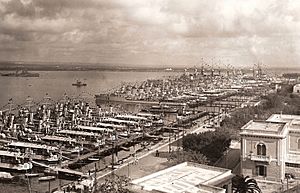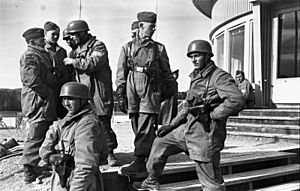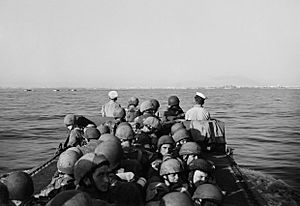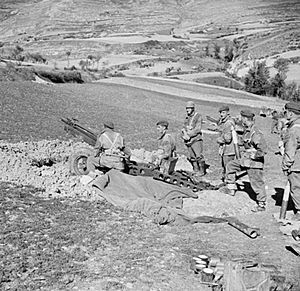Operation Slapstick facts for kids
Quick facts for kids Operation Slapstick |
|||||||
|---|---|---|---|---|---|---|---|
| Part of the Allied invasion of Italy | |||||||
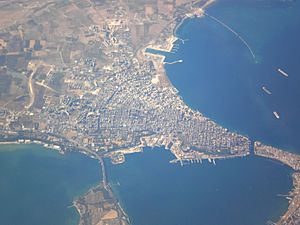 Aerial view of Taranto. |
|||||||
|
|||||||
| Belligerents | |||||||
| Commanders and leaders | |||||||
| Units involved | |||||||
| 1st Airborne Division 12th Cruiser Squadron |
1st Parachute Division | ||||||
| Casualties and losses | |||||||
| British Army: 58 dead 154 wounded Royal Navy: 48 dead HMS Abdiel sunk |
none during initial landing | ||||||
| The Field Ambulance units in the division treated 2,150 casualties, between the landing and being withdrawn. Not all of these were from the 1st Airborne Division. | |||||||
Operation Slapstick was a secret plan by the British during World War II. It involved landing soldiers from the sea at the Italian port of Taranto in September 1943. This was one of three major landings during the Allied invasion of Italy. British airborne troops, led by Major-General George Hopkinson, carried out this mission.
The plan was made quickly after Italy offered to open its ports to the Allies. The British 1st Airborne Division was chosen for the job. However, they were in North Africa and there weren't enough planes for them to parachute in. Also, all available landing craft were being used for other landings. So, the division had to travel across the Mediterranean by Royal Navy ships.
The landing at Taranto was not met with resistance. The airborne division successfully captured Taranto and later Brindisi. Both ports were in good working order. The only German soldiers nearby were from the 1st Parachute Division. They fought the British with ambushes as they slowly pulled back north. By the end of September, the British 1st Airborne Division had advanced about 125 miles to Foggia. More British soldiers arrived, allowing the airborne troops to return to Taranto. Soon after, most of the division went back to England to prepare for Operation Overlord, the invasion of Normandy.
Contents
Why Did Operation Slapstick Happen?
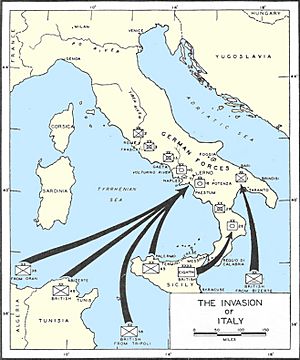
In May 1943, the Axis powers (Germany and Italy) were defeated in North Africa. Two months later, the Allied powers (Great Britain and the United States) invaded Sicily. This plan was called Operation Husky. After Sicily was taken, the Allies decided to invade Italy.
On September 3, 1943, the British Eighth Army landed in Calabria. Their goal was to capture the ports of Reggio and San Giovanni. The main invasion was set for September 9. The U.S. Fifth Army would land at Salerno on the western coast. This was called Operation Avalanche. The Allies hoped these invasions would make Italy surrender. If Italy surrendered, Germany would have to send more troops to Italy.
During secret talks in early September, the Italian government offered to open the ports of Taranto and Brindisi. German forces in that area were weak. They were expected to retreat instead of fighting. General Dwight D. Eisenhower, the top Allied commander, quickly planned a third landing. This was Operation Slapstick.
Slapstick was partly a trick to draw German forces away from Salerno. It also aimed to capture Taranto and Brindisi without damage. Taranto was important because it had a large port. Capturing it would give the Allies a supply point on Italy's eastern coast. This would be like Naples on the western coast.
This military action also played a big political role. The Italian government leaders, including King Vittorio Emanuele III and Prime Minister Badoglio, fled from Rome to Brindisi after the surrender. British troops quickly took control of Brindisi. This kept the Italian leaders safe. It also allowed Italy to declare war on Germany.
What Was Taranto Like?
Taranto is a city in the Apulia region of Italy. It has a large harbor. The harbor is protected by two small islands. The main commercial port is in the "Big Sea" bay. After Italy became one country, Taranto became the main base for the Italian Navy.
The military port was in another bay called the "Small Sea." In November 1940, the British Navy attacked the naval base in Taranto. They sank some Italian battleships.
Getting Ready for the Landing
German Forces in the Area
The German High Command knew Italy might surrender. They secretly set up a new army group led by Generalfeldmarschall Erwin Rommel. He was supposed to get many divisions, but a Russian attack prevented some from being sent. Adolf Hitler realized that without the Italian Army, Germany could not defend all of Italy.
In Italy, German Generalfeldmarschall Albert Kesselring was making his forces stronger. Three German divisions escaped from Sicily and crossed to Italy safely. In August, five infantry and two tank divisions moved into northern Italy. After losing Sicily, Hitler changed his plans. He decided to hold the Salerno-Naples area. The 1st Parachute Division was sent to the Apulia region.
This 1st Parachute Division was led by Generalmajor Richard Heidrich. It was a very experienced division. It had fought in Greece, Crete, and the Soviet Union. It had also fought against British paratroopers in Sicily. However, on September 9, only a few of its fighting groups were in Apulia.
British Forces Preparing
Plans were made on September 6 to move the British 1st Airborne Division from North Africa to Taranto. They would use Italy's surrender to capture the port. They also needed to set up anti-aircraft defenses. The Allies thought there would be little resistance. Taranto was too far for Allied fighter planes from Sicily to help much.

The British 1st Airborne Division had never fought as a complete unit before. Only the 1st Parachute Brigade had combat experience from North Africa and Sicily. They had suffered many losses in Sicily. The other brigades, the 2nd and 4th Parachute Brigades, had not fought in battle yet. The 4th Parachute Brigade was also missing one of its battalions.
There were not enough planes to carry a whole division by air. So, the 1st Airborne Division had to travel by sea. No landing craft were available quickly. So, the division was carried by four cruisers of the Royal Navy's 12th Cruiser Squadron. These ships were HMS Aurora, HMS Penelope, HMS Dido, and HMS Sirius. They were joined by the minelayer HMS Abdiel and the American cruiser USS Boise. All these ships were led by Commodore W.G. Agnew. If the landing worked, two more infantry divisions would be sent to help the airborne division.
The Landing at Taranto
The 1st Airborne Division was split into two groups before leaving Tunisia. The first group, including the division's headquarters and two parachute brigades, boarded Royal Navy ships at Bizerta. They left at 5:00 PM on September 8. Their ships were full of vehicles and supplies. Admiral Sir Andrew Cunningham was worried. He thought the Italian battle fleet at Taranto might attack the British cruisers. So, he ordered two battleships and six destroyers from Malta to join the group. At 6:30 PM on September 8, while at sea, General Dwight D. Eisenhower announced Italy's surrender.
To help the British landing, American planes attacked Scanzano Jonico early on September 9. As the British ships neared Taranto, Italian battleships and cruisers were seen leaving the harbor. The British ships got ready for battle. But the Italian ships just sailed past them. They were heading to Malta to surrender, as agreed. At 3:00 PM, the British ships reached the minefield protecting Taranto's entrance. A destroyer, HMS Javelin, went through the minefield into the harbor. Two hours later, Javelin returned with an Italian harbor pilot.
HMS Penelope and USS Boise were guided safely into the harbor. They docked and unloaded their troops. The other ships stayed outside the port and used small boats to take their soldiers ashore. The port's facilities were working well. They quickly began unloading the ships.
The first soldiers ashore were from the 4th Parachute Brigade. They moved inland to guard against a German attack. When the airborne troops entered Taranto, the Italian soldiers welcomed them. They said the German forces had already left. Once the two brigades were unloaded, they moved through the city. They set up defenses to the north. At the same time, Major-General George F. Hopkinson set up his headquarters. He accepted Italy's surrender from the military governor.
After safely landing the first group, the 12th Cruiser Squadron went back to Bizerta. They picked up the rest of the troops. These included the 2nd Parachute Brigade and the 1st Airlanding Brigade. The only losses during the landing happened on September 10. HMS Abdiel hit a mine and sank while moving near the dock. This caused 58 deaths and 154 injuries among the soldiers. Also, 48 of Abdiel's crew died. Abdiel was also carrying anti-tank guns and the division's extra ammunition.
Overnight, the 4th Parachute Brigade led the advance inland. By dawn on September 10, they reached Massafra. The people there welcomed them. The next town was Mottola, which was still held by the Germans. The Germans fought back a little but soon pulled out. This was the first time the division had soldiers killed or wounded in combat. The wounded were taken to Taranto.
The German paratroopers tried to slow the British advance. They set up ambushes and roadblocks. At a roadblock near Castellaneta, Major-General Hopkinson was hit by German machine gun fire. He was observing the attack by the 10th Parachute Battalion. He died from his wounds the next day. Brigadier Ernest Down took over as the division commander.
Within two days of landing, the airborne division reached and took control of Brindisi and Bari. They faced no resistance because the Italian army still held these cities. On September 11, the British 1st Canadian Infantry Division made contact with the airborne division. This was the leading unit of the British Eighth Army. By the evening of September 12, the 1st Airborne Division had moved 20 miles inland on foot.
The airborne division's next goal was the airfield at Gioia del Colle. The Royal Air Force needed this airfield. They wanted to bring in fighter planes from Sicily. These planes would support the Salerno landings, which were not going as planned. The Germans kept retreating. The 10th and 156th Parachute battalions reached Gioia on the night of September 16/17. The Royal Air Force took over the airfield. Two days later, six squadrons were flying from there.
Between September 20 and 24, the 1st Airborne Division was told to stop. They were to build defenses near Taranto. There were worries that the Germans might attack the spread-out British units.
The V Corps headquarters landed at Taranto on September 18. They prepared for two more divisions to arrive. The British 78th Infantry Division started arriving at Bari on September 22. The 8th Indian Infantry Division arrived at Taranto the next day. On September 24, the 1st Parachute and 1st Airlanding brigades continued the advance. By September 27, they and the 78th Division reached Foggia, 125 miles from Taranto. From there, the airborne division was sent back to Taranto. By November, most of the 1st Airborne Division had left for England.
What Happened After Operation Slapstick?
Operation Slapstick did not trick the Germans as General Eisenhower had hoped. The German commander, Heidrich, decided not to fight the landings. He did this without asking his headquarters. Heidrich expected a huge Allied force. So, he pulled his units north. However, he tried to slow the Allies down with ambushes and roadblocks. The German division later fought hard against the Allies at the Battle of Monte Cassino in 1944.


